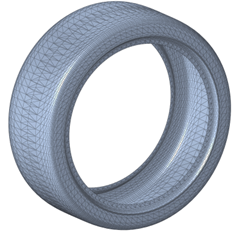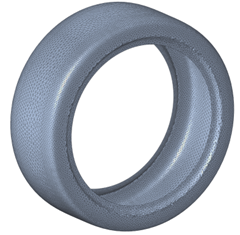Remesh Tessellated Models
Use the Remesh to create new surface mesh on converted geometry.
The Remesh tool works for tessellated geometry. If the input is b-spline geometry, first convert to discrete geometry using the Convert tool.
-
From the Discrete ribbon, click the Remesh tool.
Figure 1. 
- Select surfaces, parts, or elements to remesh.
-
Define meshing options in the dialog.
- Mesh size
- Maximum allowable element size.
- Curvature based refinement
- Refine mesh at curvatures and features by lowering mesh size till minimum size. If off, creates constant size mesh defined by Mesh size.
- Minimum size factor
- Minimum allowable element size factor. Calculates minimum size by
multiplying mesh size with factor defined here.
When there are model and local mesh controls for surface deviation, and the minimum size of neighboring mesh controls are different, the minimum size automatically propagates from the smaller mesh size to neighboring surfaces.
- Geometric feature angle
- Determines which features to preserve/refine. The mesher identifies
features internally and preserves/refines them based on the defined
feature angle.
Also controls the element size at curve input. The smaller the angle, the more refined curvature will be and the more preserved the input shape will be.
Figure 2. Angle β is the span angle of the edge ab. The length of ab is less than 2R( sin β/2 ). 
- Mesh growth rate
- Determines how rapidly elements can increase in size as they are created further and further away from features.
-
Click Mesh on the guide bar.
Figure 4. Input 
Figure 5. Remesh result with feature angle 22.5 
